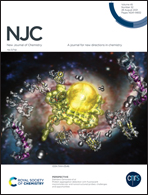Slow magnetic relaxation and luminescence properties in neodymium(iii)-4,4,4-trifluoro-1-(2-naphthyl)butane-1,3-dionato complexes incorporating bipyridyl ligands†
Abstract
Five new eight-coordinated Nd(III) mononuclear complexes with the formulae [Nd(ntfa)3(EtOH)2] (1), [Nd(ntfa)3(phen)] (2), [Nd(ntfa)3(bipy)] (3), [Nd(ntfa)3(5,5′-Me2bipy)] (4) and [Nd(ntfa)3(4,4′-Mt2bipy)] (5), where ntfa = 4,4,4-trifluoro-1-(naphthalen-2-yl)butane-1,3-dionate, phen = phenanthroline, bipy = 2,2′-dipyridine, 5,5′-Me2bipy = 5,5′-dimethyl-2,2′-dipyridine, and 4,4′-Mt2bipy = 4,4′-dimethoxy-2,2′-dipyridine, were synthesized and structurally characterized. Magnetic measurements were carried out on complexes 2–5. Dynamic magnetic studies revealed single-molecule magnet (SMM) behavior for complexes 2, 4 and 5 with anisotropy energy barriers and preexponential factors of Ueff = 18 cm−1, τ0 = 2.2 × 10−7 s; Ueff = 31 cm−1, τ0 = 1.0 × 10−9 s and Ueff = 19 cm−1, τ0 = 8.7 × 10−8 s, respectively. The ancillary chelating bipyridyl ligands in complexes 2–5 greatly enhance the solid state luminescence emission in the visible and NIR regions through efficient energy transfer from the ligands to the central Nd3+ ion. This study highlights the bifunctionality of the Nd(III) complexes.



 Please wait while we load your content...
Please wait while we load your content...